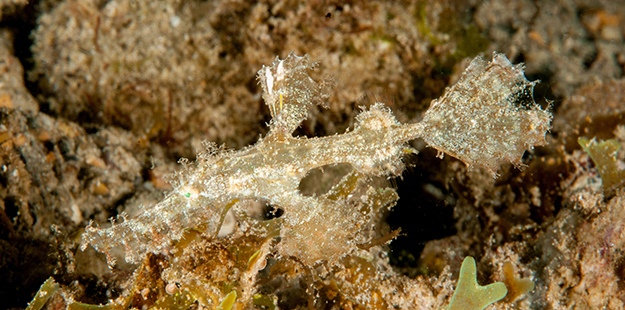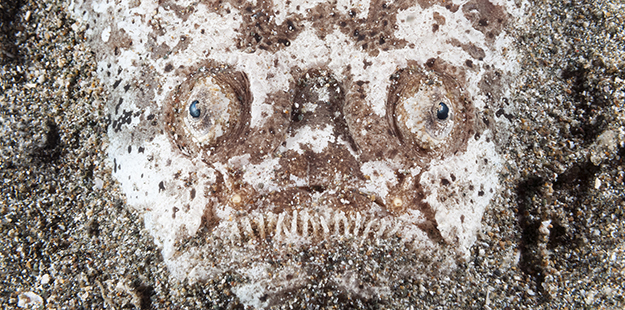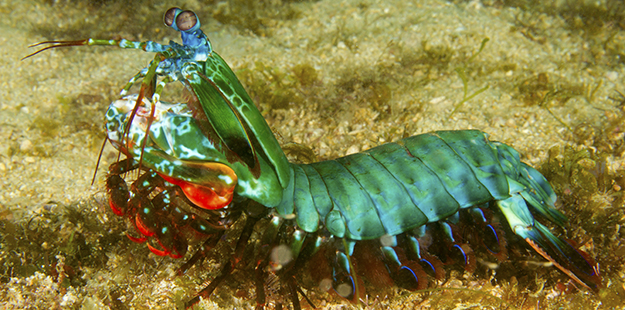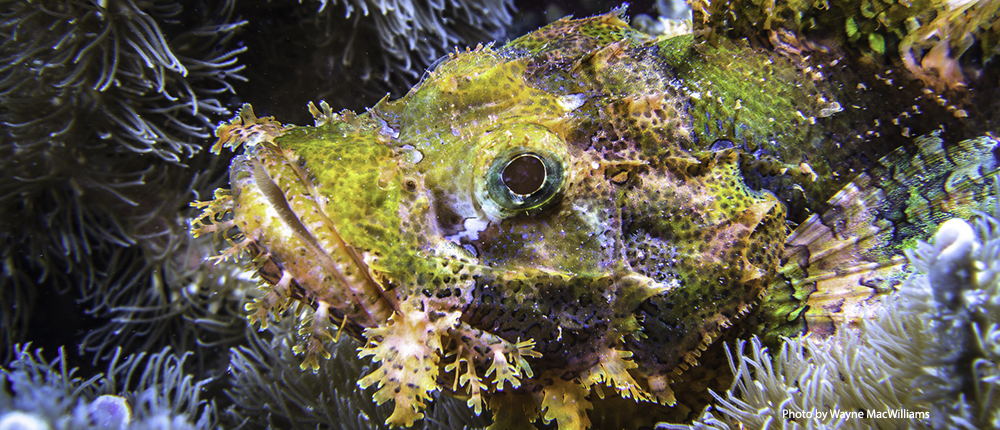Ambush Artists
Seeing ghosts
That leaf of seagrass swaying gently in the surge… it might not be what it seems. Look close, real close, and it might reveal itself to be a robust ghost pipefish. Don’t feel bad if you missed seeing it at first. Ghost pipefish are among the most masterful disguise artists in the ocean.

Relatives to both seahorses and pipefish, ghost pipefish are typically no longer than 15 cm (5.9 in), feeding on tiny crustaceans, sucked inside through their long snout. Photo by Eric Schlogl
Some take on the drab shades and shapes of sea grass or algae, others use intricate color patterns and frilly appendages to mimic whip or gorgonian corals. Relatives to both seahorses and pipefish, these elusive creatures use their concealment abilities not only to elude predators, but also to approach potential prey. Some may drift with the current, while others hold station and wait for food to come their way. Whatever the hunting strategy, they will ultimately capture their prey with a spring-loaded snap of their snout that serves to suck their victim right into the mouth. If you plan to go on a ghost hunt at Wakatobi, you stand your best chance of locating them in sheltered shallows areas where there is little current. Finding one isn’t easy, and there’s no shame in asking one of Wakatobi’s dive guides for assistance, as they have developed an almost uncanny ability for spotting these elusive little hunters.

Any palatable morsel that comes within range of the spooky stargazer has little chance of escape once he bursts forth with an upward attack. Photo by Walt Stearns
Shock and awe
Swim across a patch of open bottom at Wakatobi and you might be entering a biological minefield. Look close and you might spot a pair of eyes protruding from the sand or muck. These peepers likely belong to a stargazer. If this fish were out in the open, you’d note the bulging bulldog-like eyes are set in a large head, which tapers to a disproportionately small body. Adding to the stargazer’s ghoulish appearance is a downturned mouth fitted with a jagged row of teeth. In some cases, there might also be a worm-like lure growing from the mouth looking like a party favor used to lure unsuspecting prey. Whether enticed closer by biological trickery or simply wandering past unaware, any palatable morsel that comes within range of this spooky carnivore will have little chance of escape once the stargazer bursts forth in an upward attack. Giving their strike that awe factor, several types of stargazers found at Wakatobi pack an additional surprise–an electric shock. Specialized muscles in the stargazer’s head can generate electrical charges of up to 50 volts. At one point, biologists thought the electric stargazers used this ability to stun prey, but the charge really isn’t great enough to immobilize most fish. It may, however help confuse the victim and buy the stargazer that extra few milliseconds needed to complete the kill.
Preying mantis
The peacock mantis shrimp has earned notoriety for having the fastest feeding strike of any animal in the world. Wielding its club-like appendages at the speed of a .22-caliber slug, this formidable shrimp is a “smasher” that can shatter clamshells with ease, or slice human fingers to the bone. With such a formidable weapon at its disposal, the peacock mantis isn’t afraid to roam the crevices of the reef. But there are other members of the mantis shrimp family who are not so bold, and who strike from cover.

Referred to as a “smasher,” the Peacock mantis shrimp has the fastest feeding strike of any animal in the world. Photo by Walt Stearns

Scientists have discovered that other members of the mantis shrimp family, referred to as “spearers,” actually strike a bit slower than smashers, but still pack a powerful punch. Photo by Marco Fierli
Rather than hammer claws, they sport sharp appendages that are used to impale a range of softer prey. Often referred to as the “spearers,” these shrimp keep to their burrows, waiting for something tasty to swim past. In the course of measuring strike speeds, scientists discovered that the spearers actually strike a bit slower than the smashers. But this isn’t necessarily a disadvantage, because the attack is still faster than most quarries can react, and it appears that a slightly slower strike speed allows for greater accuracy and a longer distance strike.
Observing an ambush predator at work takes both patience and vigilance. For long periods of time, nothing happens. Then, in less than a tenth of the time it takes to blink your eyes, the attack comes. It’s a literal case of blink and you’ll miss it. But don’t worry, you can catch a repeat performance, as the ongoing drama of the sneak attack plays out uncounted times each day. It’s just one more element in the ongoing show on Wakatobi’s reefs.
A visit to Wakatobi is an opportunity to embrace nature while also enjoying the unpretentious luxury of our surroundings. It’s time for you to experience all that Wakatobi has to offer. Email us at office@wakatobi.com or complete a quick trip inquiry at wakatobi.com.
Visit us on Facebook.


